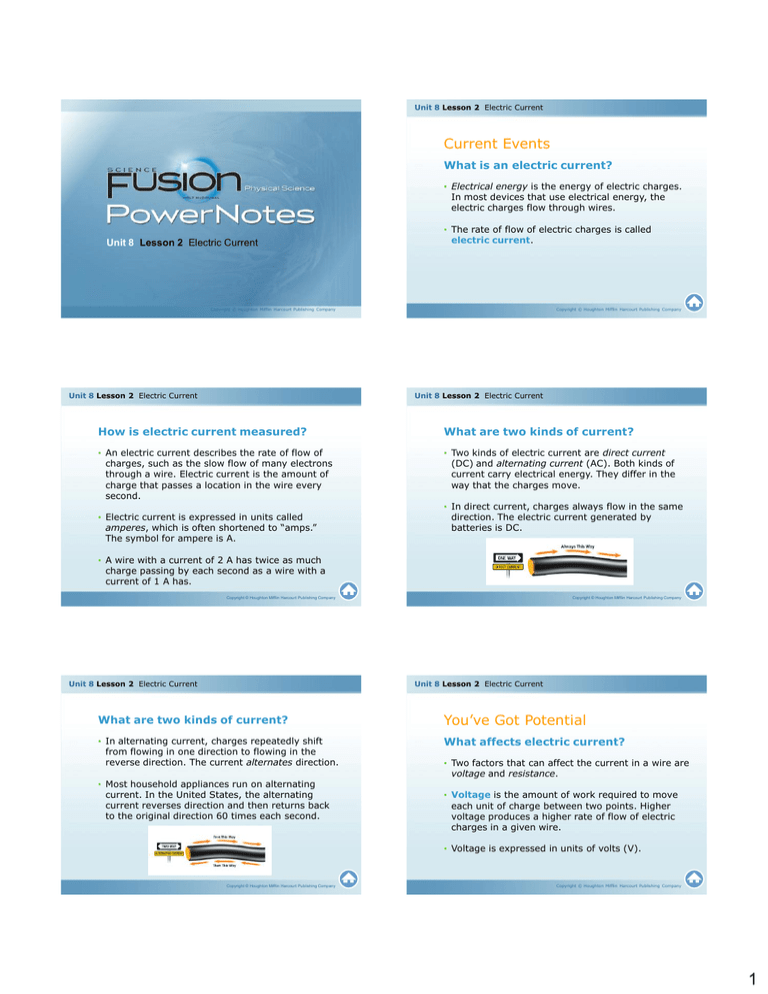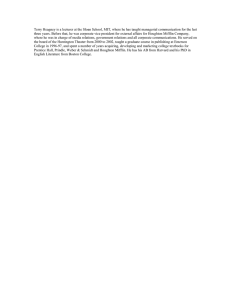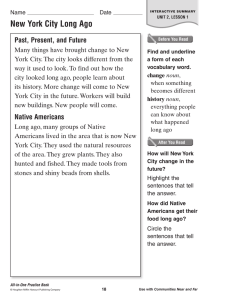Current Events You`ve Got Potential
advertisement

Unit 8 Lesson 2 Electric Current Current Events What is an electric current? • Electrical energy is the energy of electric charges. In most devices that use electrical energy, the electric charges flow through wires. Unit 8 Lesson 2 Electric Current • The rate of flow of electric charges is called electric current. Copyright © Houghton Mifflin Harcourt Publishing Company Unit 8 Lesson 2 Electric Current Copyright © Houghton Mifflin Harcourt Publishing Company Unit 8 Lesson 2 Electric Current How is electric current measured? What are two kinds of current? • An electric current describes the rate of flow of charges, such as the slow flow of many electrons through a wire. Electric current is the amount of charge that passes a location in the wire every second. • Two kinds of electric current are direct current (DC) and alternating current (AC). Both kinds of current carry electrical energy. They differ in the way that the charges move. • Electric current is expressed in units called amperes, which is often shortened to “amps.” The symbol for ampere is A. • In direct current, charges always flow in the same direction. The electric current generated by batteries is DC. • A wire with a current of 2 A has twice as much charge passing by each second as a wire with a current of 1 A has. Copyright © Houghton Mifflin Harcourt Publishing Company Unit 8 Lesson 2 Electric Current Copyright © Houghton Mifflin Harcourt Publishing Company Unit 8 Lesson 2 Electric Current What are two kinds of current? You’ve Got Potential • In alternating current, charges repeatedly shift from flowing in one direction to flowing in the reverse direction. The current alternates direction. What affects electric current? • Most household appliances run on alternating current. In the United States, the alternating current reverses direction and then returns back to the original direction 60 times each second. • Two factors that can affect the current in a wire are voltage and resistance. • Voltage is the amount of work required to move each unit of charge between two points. Higher voltage produces a higher rate of flow of electric charges in a given wire. • Voltage is expressed in units of volts (V). Copyright © Houghton Mifflin Harcourt Publishing Company Copyright © Houghton Mifflin Harcourt Publishing Company 1 Unit 8 Lesson 2 Electric Current Unit 8 Lesson 2 Electric Current What affects electric current? What affects electrical resistance? • Voltage is sometimes called electric potential because it is a measure of the electric potential energy per unit charge. • A material’s composition affects its resistance. • The opposition to the flow of electric charge is called resistance. Resistance is expressed in ohms (Ω, the Greek letter omega). • Higher resistance at the same voltage results in lower current. • Some metals, such as silver and copper, have low resistance and are very good electrical conductors. Other metals, such as iron and nickel, have a higher resistance. • Electrical insulators such as plastic have such a high resistance that electric charges cannot flow in them at all. Copyright © Houghton Mifflin Harcourt Publishing Company Unit 8 Lesson 2 Electric Current Copyright © Houghton Mifflin Harcourt Publishing Company Unit 8 Lesson 2 Electric Current What affects electrical resistance? What affects electrical resistance? • Other factors that affect the resistance of a wire are thickness, length, and temperature. • Conductors with low resistance, such as copper, are used to make wires. • A thin wire has higher resistance than a thicker wire has. • Conductors with high resistance are also useful. For example, an alloy of nickel and chromium is used in heating coils. Its high resistance causes the wire to heat up when it carries electric current. • A long wire has higher resistance than a shorter wire has. • A hot wire has higher resistance than a cooler wire has. Copyright © Houghton Mifflin Harcourt Publishing Company Copyright © Houghton Mifflin Harcourt Publishing Company 2

